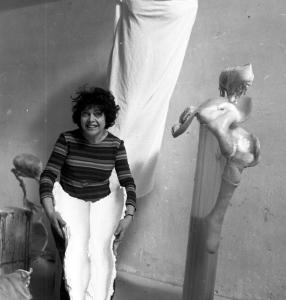Alina Szapocznikow Documents. Works. Interpretations
Anke Kempkes
In the late 1960s and early 1970s a new dimension of artistic practice is subtly entering Alina Szapocznikow’s body of work.
We see her experimenting with certain specific aspects of art-making fashioned at the time. Surrounded in Paris by a climate of neo-avant-garde and counter-cultural activities, Szapocznikow expands her perspective on sculpture in directions of conceptual experimenting. Yet she re-orients her work in nuances, finds directions which are articulated often only in semi-private accounts, never as part of a loud movement, but in highly individual forms of approach. At the same time she never betrays her core thinking-in-sculpture and her legacy of poetic existentialism and morbid-entropic surrealism. While she was therefore regarded by her contemporaries as potentially too individual and her vision of the body too traumatically inflicted and too provocatively sexual for getting fully absorbed into the new movements, we can see today that the radicalism of her artistic experiments lies in her unique proto-feminist vision as well as precisely in her independence (having been at the center and coevally on the margin of recognition) which allowed her to explore astonishing sites of her practice, presided over by the visions of pioneers such as Robert Smithson and others. That the cutting-edge-status of her work could not be fully read at the time has numerous reasons and constitutes an art historical cluster with blanks, which can be reconstructed partially. As the discourse-based paradigms of art taste and fashion move on and are in constant modification, we can today appreciate and evaluate in Szapocznikow’s work exactly the interplay of aspects and articulations that made her work to a degree incommensurable at her times.

